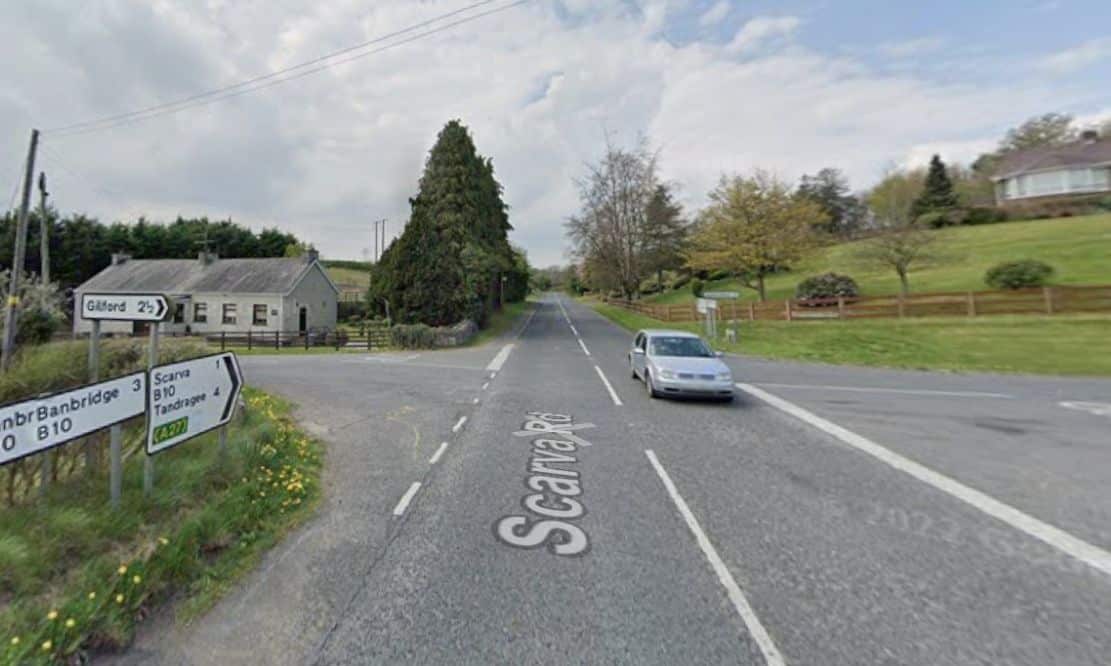
There are around 200 identified traffic-collision blackspots in the Southern Division alone, however financial constraints mean only one or two per year can be made safer.
The information was revealed by Department for Infrastructure (DfI) acting divisional roads manager for the Southern Division, Cindy Noble.
One such hazardous spots which she singled out for mention is the Scarva Road/Lisnagade Road junction, outside Scarva – it is to be staggered to enhance safety.
The senior DfI representative made her comments at last Monday’s (October 27) monthly meeting of Armagh City, Banbridge & Craigavon (ABC) Borough Council, as she was presenting DfI Roads Southern Division’s Annual Report 2025-26.
Councillor Lavelle McIlwrath (DUP, Portadown DEA) expressed frustration in relation to what he considers to be well-known hazardous spots where collisions are reported regularly.
He commented: “I have a huge issue across my DEA, and that’s accident blackspots on our A-class roads, our main roads.
“[These are] roads that have been identified clearly as [having] issues [with] multiple accidents, and I think in particular of the Dungannon Road, particularly in the area of Wrights’ filling station. That’s been raised by a number of representatives.
“And also on the Mahon Road, at Haldane Fisher [Landscaping & Building Supplies]. Some bad accidents there recently. And outside of my DEA, a road that I use quite often on the main Armagh-Newry Road at Gosford, Markethill, with multiple junctions.
“When there was an area identified some years ago with serious accidents, namely The Dobbin on the main Armagh-Portadown Road, we were able to reduce the speed limit from 60mph to 50mph on a small section.
“And the worth of that is untold. There was an accident there practically every week, and it’s been reduced dramatically. So, why can we not do small sections of these really bad blackspots? There’s no other country in the world probably that would allow this to continue.
“I did a little bit of research under Freedom of Information, and the Southern HSC Trust tell me that 3,000 people have been treated in the last 12 months in the Trust as a result of road-traffic collisions.
“Almost 20 are detained for treatment every week in the Southern Trust. So, if we can reduce that in any way, I think we should be looking at it. Members across the chamber can probably relate to main roads in their areas that could do with a speed reduction.
“I think we could do it cheaply, it’s not something that we need to spend tens of thousands on, but it can have a dramatic reduction. And that’s the point, saving lives, saving injuries on our roads and reducing the pressure on our hospitals as well.”
Addressing Councillor McIlwrath’s concerns, the DfI acting divisional roads manager stated: “Road safety is a priority, and just to answer your question, there is going to be probably before the end of the year a consultation with regards to a speed-limit review.
“It’s really part of co-ordinated measures that the minister and the Department are looking at. Not just engineering measures, but what we can do in relation to society issues with regards to road speeding.
“So, there’s going to be a consultation that will look at speed limits, and whether they’re appropriate in rural areas. It will also look at possibly reducing speed limits for HGVs, and also the part-time 20mph [speed limits] that we have at our schools.
“Is there an appetite and a feeling that 20mph zones could be extended beyond schools in residential areas?
“It’s been done in other jurisdictions and has proven quite successful, but speeding is not just about engineering measures. It’s society’s attitude to speeding as well, because we’re all personally responsible for making sure that we drive to the speed limit.
“In relation to engineering measures, one of the things that Southern Division is currently doing, is that we are looking at our collision remedial sites, and that’s sites where there has been three or more accidents in four calendar years.
“And in this Division, I think we’re up to about 200 of those sites, so we’re prioritising those currently.
“We’re doing what we call a cluster review of those sites, to see if there are similar causation factors in those locations, and if there are engineering measures that we can do that would reduce that.
“But at the minute, our budgets are very limited, so it’ll be on the basis of maybe one or two per year depending on the funds, things like Lisnagade crossroads, that’s one of those sites.
“And that’s how we’re able to try and develop programmes and designs that are appropriate for those locations, looking at the causation factors in those accidents, and looking to see what engineering measures we can [deliver].
“In that case, a staggered crossroads is probably the most appropriate engineering solution.”




